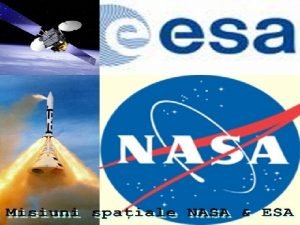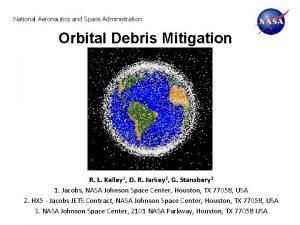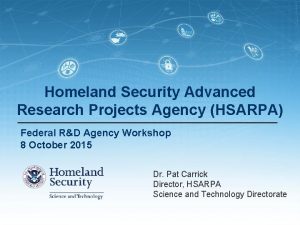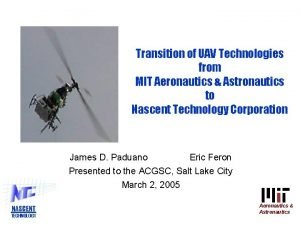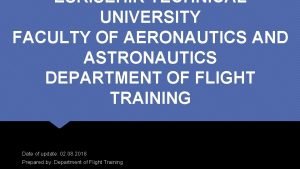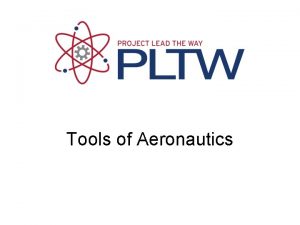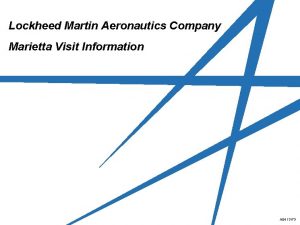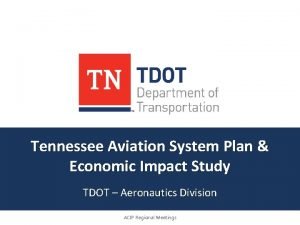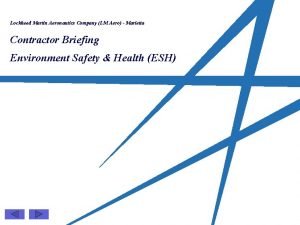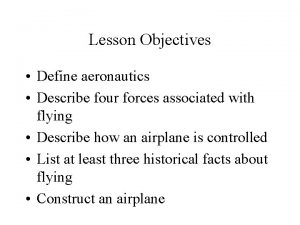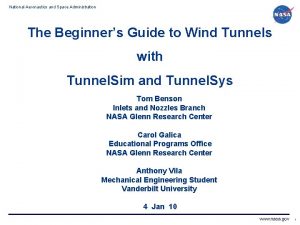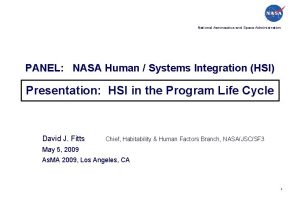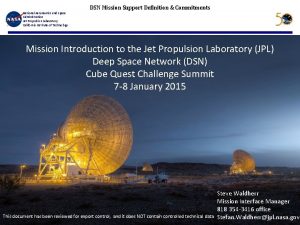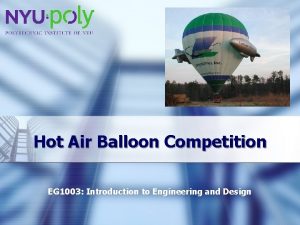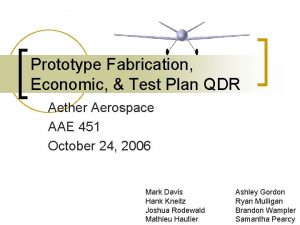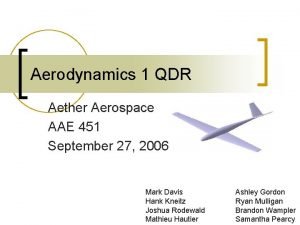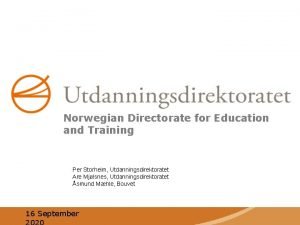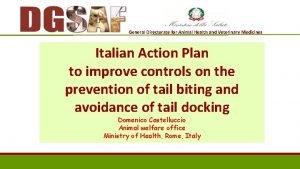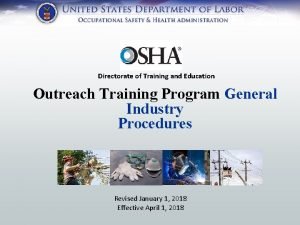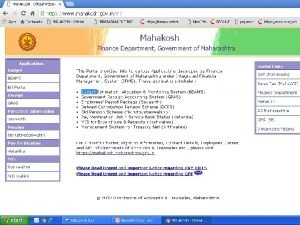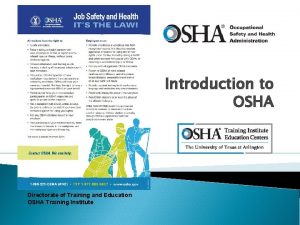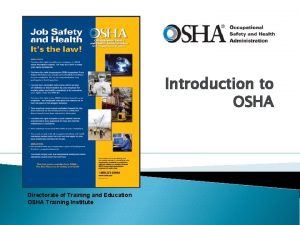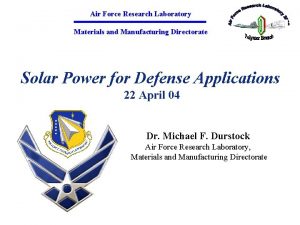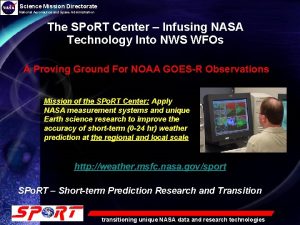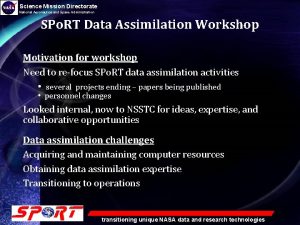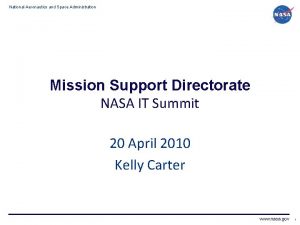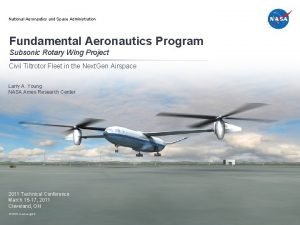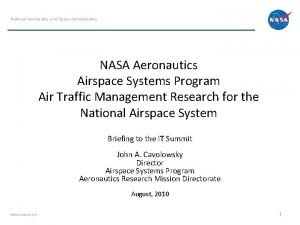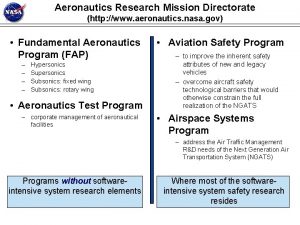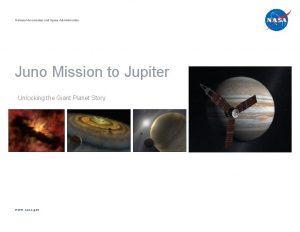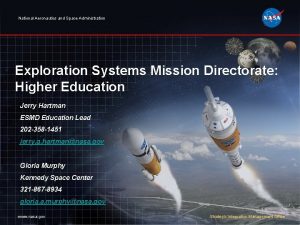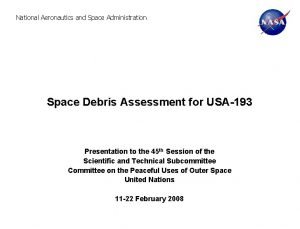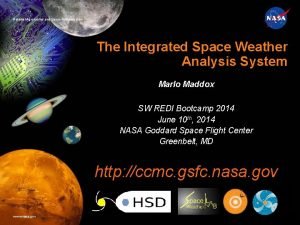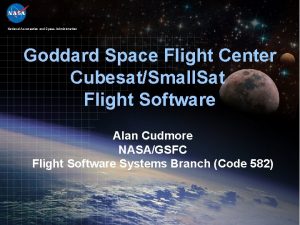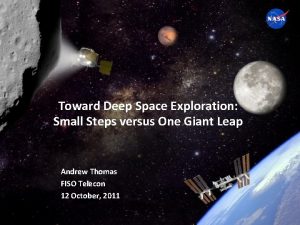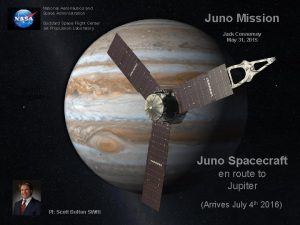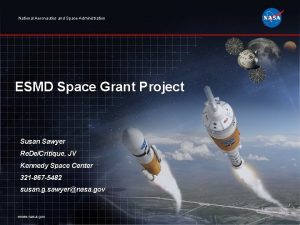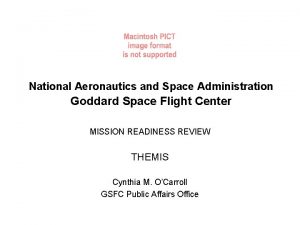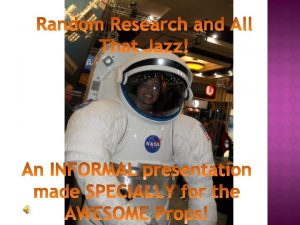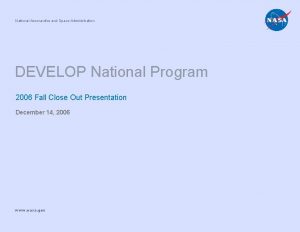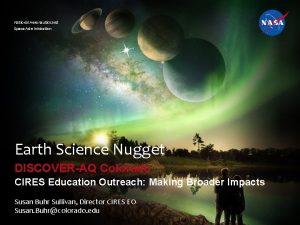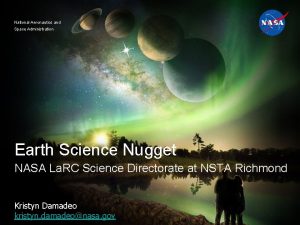National Aeronautics and Space Administration Science Mission Directorate
























- Slides: 24

National Aeronautics and Space Administration Science Mission Directorate Overview Presenter: Dr. Rich Terrile Jet Propulsion Laboratory, California Institute of Technology MD: SMD Date: 6/26/17 TIME: 11: 35 PST I N N O V A T I O N SMALL BUSINESS | INNOVATION P A R T N E R S H I P RESEARCH (SBIR) & SMALL | C O M M E R C I A L I Z A T I O N BUSINESS TECHNOLOGY TRANSFER (STTR)

Science Mission Directorate Overview • Science Mission Directorate (SMD) – One of Four NASA Mission Directorates • • Science Mission Directorate (SMD) Aeronautics Research Mission Directorate (ARMD) Human Exploration and Operations Mission Directorate (HEOMD) Space Technology Mission Directorate (STMD) – SMD is Comprised of Four Divisions • Astrophysics – Core NASA Centers: GSFC, MSFC, JPL • Earth Science – Core NASA Centers: GSFC, La. RC, JPL • Heliophysics – Core NASA Center: GSFC • Planetary Science – Core NASA Centers: JPL, GSFC 2

Topic Overview 3

NASA’s Science Mission Directorate Make possible accurate predictions of solar phenomena throughout the solar system Technologist: Dan Moses Explore habitable environments across the solar system with human and robotic explorers Technologist: Leonard Dudzinski Enable more accurate and useful environmental predictions, including weather, climate, natural and human Induced events Technologist: Earth Science Technology Office Answer the question: “Are we alone? ” Technologist: William Lightsey SMD technology tasks have science traceability to external roadmaps, reports and surveys.

NASA’s Science Mission Directorate Answer the question: “Are we alone? ” Technologist: William Lightsey

NASA’s Science Mission Directorate Enable more accurate and useful environmental predictions, including weather, climate, natural and human Induced events Technologist: Earth Science Technology Office

NASA’s Science Mission Directorate Make possible accurate predictions of solar phenomena throughout the solar system Technologist: Dan Moses

NASA’s Science Mission Directorate Explore habitable environments across the solar system with human and robotic explorers Technologist: Leonard Dudzinski

Topic Overview 9

SMD Goals and Selection Path SMD SBIR Goal: Solicit and select the best technical efforts that can deliver what NASA projects need, that can be accomplished by small businesses with SBIR resources, and that have high center advocacy for infusion. Solicitation Development: • Create subtopics with science traceability and infusion potential § § • Develop tasks appropriate to small businesses § § § • Should articulate specific benefits for NASA missions and goals When possible, should trace to timely science mission requirements No “critical path” deliverables or large, complex systems End product/capability should also provide a path to an attractive return on investment for small business Encourage a sustainable supply chain for technology Balance the SMD Technology portfolio § § Solicit innovative solutions to NASA challenges Select a mix of innovative ideas and technological solutions 10

SMD Science Traceability • SMD technology tasks must have science traceability to external roadmaps, reports and surveys – SMD has the unique benefit of science goals and measurement objectives from external committees • Decadal Surveys • NASA Advisory Committees • NRC Reports – Survey data is constantly being updated by latest results and discoveries (e. g. Direct detection of gravitational waves) • Resources: https: //science. nasa. gov/about-us/science-strategy 11

SMD Fields LRD: 2018 2003 1990 1999 Ø Ø 2010: New Worlds, New Horizons in Astronomy and Astrophysics 2020 Vision: An Overview of New Worlds, New Horizons in Astronomy and Astrophysics § § Our Dynamic Space Environment: Science and Technology Roadmap for 2014 -2033 Heliophysics Technology and Instrument Development for Science LRD: 2018 LRD: 2017 LRD: 2015 2012 12

JPL SBIR in Space – Curiosity Grammatech - Software for eliminating defects in missioncritical and embedded software applications directing rover operations Yardney Technical Products – Lithium ion batteries that enable the power system to meet peak power demands or rover activities Starsys Research - Planetary gearboxes for the articulated robotic arm and the descent braking mechanism for controlling rate of descent to planetary surface Honeybee Robotics – Dust removal tool used to remove the dust layer from rock surfaces and to clean the rover’s observation tray and designed the sample manipulation system for the Sample Analysis at Mars (SAM) instrument package Creare - A space-qualified vacuum pump for the Sample Analysis at Mars (SAM) instrument package ABOUT THE MISSION The Mars Science Laboratory mission's Curiosity rover, the most technologically advanced rover ever built, landed in Mars' Gale Crater the evening of Aug. 5, 2012 PDT (morning of Aug. 6 EDT) using a series of complicated landing maneuvers never before attempted. The specialized landing sequence, which employed a giant parachute, a jet-controlled descent vehicle and a bungee-like apparatus called a "sky crane, " was devised because tested landing techniques used during previous rover missions could not safely accommodate the much larger and heavier rover. in. Xitu– Features of their automated sample handling system are implemented in the Chemistry and Mineralogy experiment (Che. Min) instrument Curiosity's mission is to determine whether the Red Planet ever was, or is, habitable to microbial life. The rover, which is about the size of a MINI Cooper, is equipped with 17 cameras and a robotic arm containing a suite of specialized laboratory-like tools and instruments. 13

JPL SBIR in Space – Phoenix Mission Icy Soil Acquisition Device supplied by Honeybee Robotics, Inc. Space. Dev contributed wet chemistry elements of the Microscopy Electrochemistry and Conductivity Analyzer (MECA) ABOUT THE MISSION Lithium ion batteries supplied by Yardney Technical Products, Inc. Phoenix was a lander sent to the surface of Mars to search for evidence of past or present microbial life. Using a robotic arm, it could dig up to half a meter into the Red Planet to collect samples and return them to onboard instruments for analysis. Besides verifying the existence of water-ice in the Martian subsurface, Phoenix discovered traces of the chemical perchlorate, a possible energy source for microbes and a potentially valuable future resource for human explorers. As planned, the Phoenix lander ended communications in November 2008, about six months after landing, when its solar panels ceased operating in the dark Martian winter. 14

JPL SBIR in Space – Aura Mission Composite Optics provided light weight, large aperture reflector of graphite reinforced composite material with high surface accuracy for the Microwave Limb Sounder (MLS) De. Maria Electrooptics Under a $6. 5 million contract with JPL, the company provided a terahertz radiometer for the MLS Spaceborne supplied two correlator chips that make the analog to digital signal conversion and clean up the signal received by MLS Lightwave Electronics provided two diode pumped solid state lasers for Tropospheric Emission Spectrometer (TES) ABOUT THE MISSION Aura (formerly EOS/Chem-1) is the chemistry mission of NASA with the overall objective to study the chemistry and dynamics of Earth's atmosphere from the ground through the mesosphere. The mission monitors the complex interactions of atmospheric constituents from both natural and man-made sources, such as biomass burning that effect the creation and depletion of ozone. The Aura mission provides global surveys of several atmospheric constituents which can be classified into anthropogenic sources (CFC types), radicals (e. g. , Cl. O, NO, OH), reservoirs (e. g. , HNO, HCl), and tracers (e. g. , N 2 O, CO 2, H 2 O). Temperature, geopotential heights, and aerosol fields will also be mapped. Seaspace Corporation Developed low cost system that makes it possible for universities and other purchasers to receive the data transmissions from Aura 15

SMD SBIR Award History 34 43 39 36 29(3) 32(3) 35(2) 32 35 Total (Select) Subtopics 39 P 1 Ratio 23. 8% 27. 1% 23. 6% 28. 6% 17. 6% 20. 0% 27. 9% 25. 3% 27. 0% 27. 7% P 2 Ratio 53. 3% 44. 9% 57. 3% 19. 7% 34. 4% 44. 9% 37. 3% 37. 2% 37. 1% 2007 2008 2009 2010 2011 2012 2014 2015 2016 2017 16

2017 SMD SBIR Subtopics TOPIC S 1 Sensors, Detectors, and Instruments • S 1. 01 Lidar Remote Sensing Technologies • S 1. 02 Technologies for Active Microwave Remote Sensing • S 1. 03 Technologies for Passive Microwave Remote Sensing • S 1. 04 Sensor and Detector Technology for Visible, IR, Far IR and Submillimeter • S 1. 05 Detector Technologies for UV, X-Ray, Gamma-Ray and Cosmic-Ray Instruments • S 1. 06 Particles and Field Sensors and Instrument Enabling Technologies • S 1. 07 In Situ Sensors Instruments/Technologies for Planetary Science • S 1. 08 Surface & Sub-surface Measurement Systems • S 1. 09 Cryogenic Systems for Sensors and Detectors • S 1. 10 Atomic Interferometry • S 1. 11 In Situ Instruments/Technologies for Ocean Worlds Life Detection • S 1. 12 Sample Processing for Life Detection Investigations for Ocean Worlds TOPIC S 2 Advanced Telescope Systems • S 2. 01 Proximity Glare Suppression for Astronomical Coronagraphy • S 2. 02 Precision Deployable Optical Structures and Metrology • S 2. 03 Advanced Optical Systems and Fabrication/Testing/Control Technologies for EUV/Optical and IR Telescope • S 2. 04 X-Ray Mirror Systems Technology, Coating Technology for X-Ray-UV-OIR, and Free-Form Optics TOPIC S 3 Spacecraft and Platform Subsystems • S 3. 01 Power Generation and Conversion • S 3. 02 Propulsion Systems for Robotic Science Missions § § § S 3. 03 Power Electronics and Management, and Energy Storage S 3. 04 Guidance, Navigation and Control S 3. 05 Terrestrial and Planetary Balloons S 3. 06 Thermal Control Systems S 3. 07 Slow and Fast Light S 3. 08 Command, Data Handling and Electronics TOPIC S 4 Robotic Exploration Technologies § S 4. 01 Planetary Entry, Descent and Landing and Small Body Proximity Operation Technology § S 4. 02 Robotic Mobility, Manipulation and Sampling § S 4. 03 Spacecraft Technology for Sample Return Missions § S 4. 04 Extreme Environments Technology § S 4. 05 Contamination Control and Planetary Protection § S 4. 06 Sample Collection for Life Detection in Outer Solar System Ocean World Plumes TOPIC S 5 Information Technologies § S 5. 01 Technologies for Large-Scale Numerical Simulation § S 5. 02 Earth Science Applied Research and Decision Support § S 5. 03 Enabling NASA Science Through Large. Scale Data Processing and Analysis § S 5. 04 Integrated Science Mission Modeling 17

Potential New SMD Subtopics • Life Detection in Ocean Worlds – Sample collection – Sample concentration – Life detection • Integrated Systems on a Chip • Cube Sat and Small Sat Science Instruments • Information Technology and Cybersecurity • Etc. 18

Parts versus Ideas • Parts – Highly specified – Specify requirements – Solves a specific application – – Higher TRL Readily commercialized Lower perceived risk No surprises • Ideas – Not well specified – Specify goals – Potential for enabling new applications – Lower TRL – Higher perceived risk – Higher potential ROI – Surprises • Encourage innovative alternatives to address challenges with subtopics • Solicit “ideas” as well as “parts” • Creates flexibility for creative approaches to technical challenges 19

Phase I Evaluation Criteria • Evaluation Criteria – NASA intends to select for award those proposals that offer the most advantageous research and development to stimulate technical innovation to the Government and the SBIR/STTR Program. NASA will give primary consideration to the scientific and technical merit and feasibility of the proposal and its benefit to NASA interests. Each proposal will be evaluated and scored on its own merits using the factors described below: 1. 2. 3. 4. 5. Scientific/Technical Merit and Feasibility Experience, Qualifications and Facilities Effectiveness of the Proposed Work Plan Commercial Potential and Feasibility Price Reasonableness 20

Benefit to NASA Interests • NASA Interests Determined By: – Science Goals – Mission Requirements – NASA Programs • What can change NASA Interests – New Discoveries • Observatories • Lab results • Mission results – New, Canceled or Delayed Missions – Politics – Mandated changes in national priorities 21

Proposal Tips § Review prior years solicitations at http: //sbir. nasa. gov/ § Search and identify specific technical areas (subtopics) and lead center(s) of your interest § Request subject matter expert contact information from respective field center program POCs § E-mail/Call technical POCs and initiate dialogues § Learn technology needs, priorities, and funding gaps § Visit and brief NASA on your companies capabilities, if the opportunity presents itself (Industry Day) § Please note – once a solicitation is active, NASA centers, including JPL are not permitted to discuss the active solicitation 22

Proposal Advice • The proposal process begins right now, not after the solicitation is released. • Writing a winning a proposal is a long term process that involves: – Understanding the needs of NASA – Interacting with the technical community • Help us write our subtopic descriptions by letting us know what you are capable of providing. • Find out how you can best be a benefit to NASA science and technical needs. • Read the solicitation carefully. – Do not assume it is the same as last year. – Reread it again, your competition did. • Provide all of the required information, including Part 7 – Commercialization for Phase II proposals. • Explain (early and concisely) how your effort will benefit NASA interests. • You never finish writing a proposal, you just run out of time. 23

The End THANK YOU FOR YOUR PARTICIPATION! 24
 National aeronautics and space administration
National aeronautics and space administration Space debris
Space debris Dhs s&t org chart
Dhs s&t org chart Mit aeronautics and astronautics
Mit aeronautics and astronautics Pioneer astronautics internship
Pioneer astronautics internship Tools of aeronautics
Tools of aeronautics Lockheed martin marietta ga
Lockheed martin marietta ga Tdot aeronautics
Tdot aeronautics Lm aeronautics
Lm aeronautics Define:aeronautics
Define:aeronautics Beginner's guide to aeronautics
Beginner's guide to aeronautics Hsi
Hsi Aeronautics definition
Aeronautics definition Archimedes labs competitors
Archimedes labs competitors Aether aeronautics
Aether aeronautics Maximum lift coefficient formula
Maximum lift coefficient formula Acecqa self assessment tool
Acecqa self assessment tool Norwegian directorate for education and training
Norwegian directorate for education and training General directorate of animal health and production
General directorate of animal health and production Osha directorate of training and education
Osha directorate of training and education Koshwahini
Koshwahini Osha directorate of training and education
Osha directorate of training and education Osha directorate of training and education
Osha directorate of training and education Materials and manufacturing directorate
Materials and manufacturing directorate What kind of science
What kind of science
